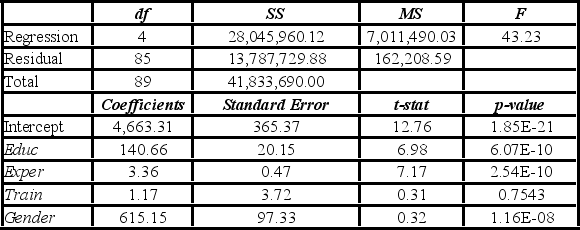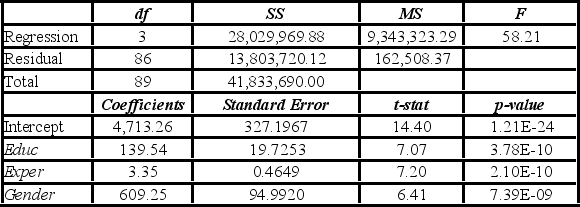To examine the differences between salaries of male and female middle managers of a large bank, 90 individuals were randomly selected, and two models were created with the following variables considered: Salary = the monthly salary (excluding fringe benefits and bonuses) ,
Educ = the number of years of education,
Exper = the number of months of experience,
Train = the number of weeks of training,
Gender = the gender of an individual; 1 for males, and 0 for females.
Excel partial outputs corresponding to these models are available and shown below.
Model A: Salary = β0 + β1Educ + β2Exper + β3Train + β4Gender + ε  Model B: Salary = β0 + β1Educ + β2Exper + β3Gender + ε
Model B: Salary = β0 + β1Educ + β2Exper + β3Gender + ε  Assuming the same years of education and months of experience, what is the p-value for testing whether the mean salary of males is greater than the mean salary of females using Model B?
Assuming the same years of education and months of experience, what is the p-value for testing whether the mean salary of males is greater than the mean salary of females using Model B?
Definitions:
Sporangia
Structures in fungi, algae, and some plants that produce and contain spores for reproduction.
Homosporous
A term referring to plants that produce only one type of spore, typically leading to the development of a single type of gametophyte.
Microspores
Small spores produced by seed plants and some ferns during the process of meiosis, which develop into male gametophytes.
Megaspores
Large spores produced by some plants that develop into female gametophytes, part of the reproductive cycle.
Q14: The R<sup>2</sup> of a multiple regression of
Q21: The quadratic regression model allows for one
Q27: A magician has a coin that may
Q42: The accompanying table shows the regression results
Q56: An inverted U-shaped curve is also known
Q78: The following table includes the information about
Q88: A market researcher is studying the spending
Q101: A model formulated as y = β<sub>0</sub>
Q122: Gender is an example of _ variable.<br>
Q130: Quantitative variables assume meaningful _, whereas qualitative